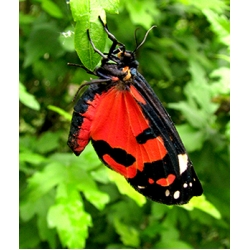- Current EGGS and LARVAE (54)
- EXOTIC BUTTERFLY PUPAE (11)
- MARKET STALL Everything a BARGAIN! (22)
- XXP super fast EXPRESS COURIER DELIVERY (2)
- CURRENT PUPAE - Chrysalides and cocoons (45)
- SILKWORM EGGS and Silkworms (6)
- SPRING and SUMMER EGGS and LARVAE Order now for supply in season (73)
- SPRING and SUMMER PUPAE You can order these NOW in advance (25)
- GIFT SUGGESTIONS (29)
- WINTER PUPAE for breeding in the following season (30)
- CAGES (10)
- PHASMIDS Leaf & Stick Insects, Mantids and more (2)
- SCHOOLS Recommended Livestock (14)
- SLEEVES for REARING LARVAE (7)
- PLASTIC REARING CONTAINERS (2)
- EQUIPMENT (29)
- MOTH TRAPS (7)
- NETTING (3)
- BOOKS (39)
- CHARTS (21)
- SPECIMENS for collectors (151)
- SILK Yarn, Fibres, Silkworm eggs (7)
Scarlet Tiger Panaxia dominula
We suggest keeping newly-hatched larvae in a soft paper-lined size 7 plastic box on a fresh leaf of Sallow or Plum. These leaves are suggested because of their keeping qualities. The larvae quickly perforate the leaf which must be changed daily. When changing the leaf, the larvae readily drop off and curl up, before scattering, which gives the opportunity to make the change. But be quick! As the larvae grow they can be moved to a larger plastic box, for further growth before sleeving either on a potted foodplant (enclose the pot and plant), or on a branch of Plum or Sallow Salix caprea.
The larvae feed on Dead Nettle, Stinging Nettle, Willow, Sallow, Bramble, Sloe and Plum. They especially like Comfrey and Borage. They often browse on other hedgerow plants. Whilst, in the wild, these larvae would hibernate, if you keep them warm and well-fed, in captivity a second brood may be possible.
Pupation is amongst litter at the base of the foodplant and the magnificent day-flying moths emerge in June. Pairing is easy. Eggs are laid loose in the herbage and the tiny larvae feed for a while before hibernation at the base of the foodplant.
Hibernation in captivity may be done in several ways, but we now suggest hibernating them sleeved, pot and all, in a large pot of Comfrey, which should be kept out of doors in all weathers, and able to drain. In nature eggs are scattered loose amongst the foliage that the larvae like to feed on. The young larvae feed and grow for some weeks before hibernating deep in the base of ground foliage. In spring they resume feeding - their spectacular yellow and black patterning making a striking site on green foliage.
Scarlet Tigers fly by day - a wonderful sight on a sunny June day. In spring the colourful caterpillars are a joy to rear and very easy on potted foodplant.










